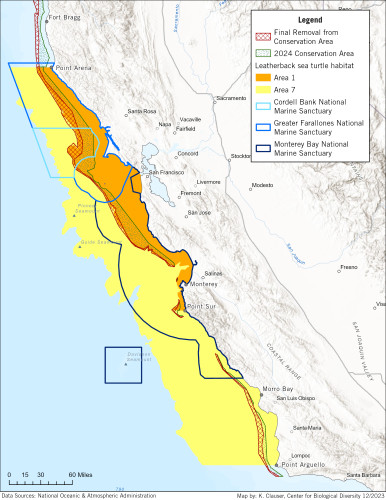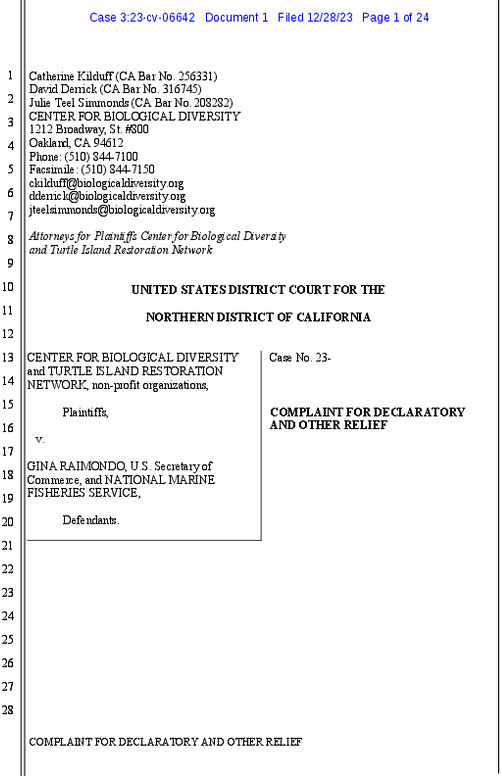From the Open-Publishing Calendar
From the Open-Publishing Newswire
Indybay Feature
California
North Bay / Marin
North Coast
Peninsula
San Francisco
Santa Cruz Indymedia
Animal Liberation
Environment & Forest Defense
Lawsuit Aims to Protect Pacific Sea Turtles From Fishing Gear
Fishery’s Expansion Threatens Endangered Leatherback Habitat Off California
SAN FRANCISCO, December 28, 2023 — The Center for Biological Diversity and Turtle Island Restoration Network sued the National Marine Fisheries Service today for failing to protect Pacific leatherback sea turtles and their critical habitat from sablefish pot gear that can entangle and drown the endangered animals.
The West Coast pot fishery for the bottom-dwelling sablefish — also known as butterfish or black cod — is now allowed to fish in conservation areas off Oregon and California that have been closed since the early 2000s. Almost 2,000 square miles of the newly opened areas are in leatherback sea turtle critical habitat, including crucial feeding areas off California’s central coast in the Cordell Bank, Greater Farallones and Monterey Bay national marine sanctuaries.
“It’s horrific that hungry leatherback sea turtles have to navigate a vast maze of fishing pot strings after migrating thousands of miles to California,” said Catherine Kilduff, an attorney at the Center for Biological Diversity. “These areas have already been designated critical habitat for the sea turtles, and they shouldn’t be a death trap. The federal government was irresponsible in rubber-stamping the reopening of these areas to dangerous sablefish pots. Leatherbacks are on the verge of extinction, and we can’t let them be killed by commercial fishing gear.”
Today’s lawsuit asserts that the reopening is likely to increase endangered leatherback sea turtle deaths and harm their principal feeding habitat in central California. West Coast entanglements in pot fishing gear are a continuing threat to endangered leatherbacks. These massive sea turtles migrate from Indonesia and then along the West Coast to feed on jellyfish and other gelatinous prey.
The sablefish fishery uses 2-mile-long strings of 30 to 50 pots each, the ends of which connect to vertical lines ending at a surface buoy. According to a 2012 Fisheries Service analysis, the sablefish pot fishery is expected to kill or injure about 1.9 leatherback sea turtles every five years. Between 2015 and 2019, before this reopening, around that many leatherback sea turtle entanglements were traced to West Coast fishing.
“Leatherbacks are drowning horrible deaths or being seriously injured when they get entangled in pot traps and this must stop immediately,” said Todd Steiner, ecologist and founder of Turtle Island Restoration Network. “With only a couple of thousand adult leatherbacks left in the Pacific, every single leatherback is critical to the survival of the species. Their fate is in our hands, and time is running out.”
The lawsuit also argues the Service failed to reanalyze the sablefish fishery’s impact when it reopened conservation areas in the leatherback’s principal feeding waters. Recent science highlights the leatherback’s continuing decline, and this action’s reopening of fishing in the leatherback’s designated critical habitat triggered additional legally required scrutiny of the action.
To make fishing safer, the Center has proposed that the Service require all fisheries that use pot gear to convert to new ropeless or “pop-up” gear within the next five years. The Center’s petition requests that the agency prioritize the transition in national marine sanctuaries, which would benefit the leatherback sea turtles feeding in central California.
Most trap and pot fisheries use static vertical lines that can wrap around sea turtles’ necks or front flippers, anchoring them to the seafloor and drowning them. Pop-up traps use lift bags or buoys on coiled ropes triggered by remote or time-release sensors to float the traps to the surface, eliminating static entangling lines.
The Dungeness crab and other crab pot fisheries are also threats to leatherback sea turtles. A leatherback was entangled and killed in November 2023 and entanglements were also documented in 2015 and 2016 — all traced to Dungeness gear. Another dead leatherback was found entangled in rock crab pot gear in 2018.
Figure 1: Leatherback sea turtle critical habitat in California consists of Area 1 in orange, the principal feeding area, and Area 7 in yellow, the secondary feeding area. The cross-hatch indicates conservation areas Fisheries Service recently reopened to sablefish pot fishing. Map by K. Clauser/Center for Biological Diversity.
The Center for Biological Diversity is a national, nonprofit conservation organization with more than 1.7 million members and online activists dedicated to the protection of endangered species and wild places.
Turtle Island Restoration Network is a global nonprofit whose mission is to inspire and mobilize people around the world to protect marine biodiversity and the oceans that sustain all life on Earth.
https://biologicaldiversity.org/w/news/press-releases/lawsuit-aims-to-protect-pacific-sea-turtles-from-fishing-gear-2023-12-28/
The West Coast pot fishery for the bottom-dwelling sablefish — also known as butterfish or black cod — is now allowed to fish in conservation areas off Oregon and California that have been closed since the early 2000s. Almost 2,000 square miles of the newly opened areas are in leatherback sea turtle critical habitat, including crucial feeding areas off California’s central coast in the Cordell Bank, Greater Farallones and Monterey Bay national marine sanctuaries.
“It’s horrific that hungry leatherback sea turtles have to navigate a vast maze of fishing pot strings after migrating thousands of miles to California,” said Catherine Kilduff, an attorney at the Center for Biological Diversity. “These areas have already been designated critical habitat for the sea turtles, and they shouldn’t be a death trap. The federal government was irresponsible in rubber-stamping the reopening of these areas to dangerous sablefish pots. Leatherbacks are on the verge of extinction, and we can’t let them be killed by commercial fishing gear.”
Today’s lawsuit asserts that the reopening is likely to increase endangered leatherback sea turtle deaths and harm their principal feeding habitat in central California. West Coast entanglements in pot fishing gear are a continuing threat to endangered leatherbacks. These massive sea turtles migrate from Indonesia and then along the West Coast to feed on jellyfish and other gelatinous prey.
The sablefish fishery uses 2-mile-long strings of 30 to 50 pots each, the ends of which connect to vertical lines ending at a surface buoy. According to a 2012 Fisheries Service analysis, the sablefish pot fishery is expected to kill or injure about 1.9 leatherback sea turtles every five years. Between 2015 and 2019, before this reopening, around that many leatherback sea turtle entanglements were traced to West Coast fishing.
“Leatherbacks are drowning horrible deaths or being seriously injured when they get entangled in pot traps and this must stop immediately,” said Todd Steiner, ecologist and founder of Turtle Island Restoration Network. “With only a couple of thousand adult leatherbacks left in the Pacific, every single leatherback is critical to the survival of the species. Their fate is in our hands, and time is running out.”
The lawsuit also argues the Service failed to reanalyze the sablefish fishery’s impact when it reopened conservation areas in the leatherback’s principal feeding waters. Recent science highlights the leatherback’s continuing decline, and this action’s reopening of fishing in the leatherback’s designated critical habitat triggered additional legally required scrutiny of the action.
To make fishing safer, the Center has proposed that the Service require all fisheries that use pot gear to convert to new ropeless or “pop-up” gear within the next five years. The Center’s petition requests that the agency prioritize the transition in national marine sanctuaries, which would benefit the leatherback sea turtles feeding in central California.
Most trap and pot fisheries use static vertical lines that can wrap around sea turtles’ necks or front flippers, anchoring them to the seafloor and drowning them. Pop-up traps use lift bags or buoys on coiled ropes triggered by remote or time-release sensors to float the traps to the surface, eliminating static entangling lines.
The Dungeness crab and other crab pot fisheries are also threats to leatherback sea turtles. A leatherback was entangled and killed in November 2023 and entanglements were also documented in 2015 and 2016 — all traced to Dungeness gear. Another dead leatherback was found entangled in rock crab pot gear in 2018.
Figure 1: Leatherback sea turtle critical habitat in California consists of Area 1 in orange, the principal feeding area, and Area 7 in yellow, the secondary feeding area. The cross-hatch indicates conservation areas Fisheries Service recently reopened to sablefish pot fishing. Map by K. Clauser/Center for Biological Diversity.
The Center for Biological Diversity is a national, nonprofit conservation organization with more than 1.7 million members and online activists dedicated to the protection of endangered species and wild places.
Turtle Island Restoration Network is a global nonprofit whose mission is to inspire and mobilize people around the world to protect marine biodiversity and the oceans that sustain all life on Earth.
https://biologicaldiversity.org/w/news/press-releases/lawsuit-aims-to-protect-pacific-sea-turtles-from-fishing-gear-2023-12-28/
For more information:
https://biologicaldiversity.org/
Add Your Comments
We are 100% volunteer and depend on your participation to sustain our efforts!
Get Involved
If you'd like to help with maintaining or developing the website, contact us.
Publish
Publish your stories and upcoming events on Indybay.
Topics
More
Search Indybay's Archives
Advanced Search
►
▼
IMC Network




